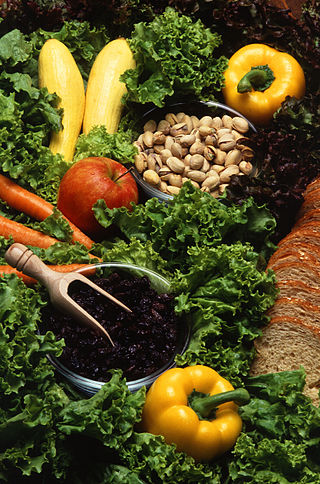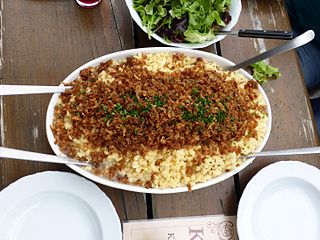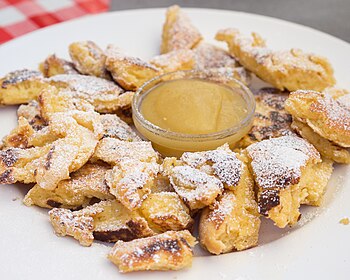
Vegetarian cuisine is based on food that meets vegetarian standards by not including meat and animal tissue products.

Vorarlberg is the westernmost state of Austria. It has the second-smallest geographical area after Vienna and, although it also has the second-smallest population, it is the state with the second-highest population density. It borders three countries: Germany, Switzerland, and Liechtenstein. The only Austrian state that shares a border with Vorarlberg is Tyrol, to the east.
Knödel or Klöße are boiled dumplings commonly found in Central European and East European cuisine. Countries in which their variant of Knödel is popular include Austria, Germany, Hungary, Poland, Romania, Bosnia, Croatia, Serbia, Slovenia, Slovakia, and the Czech Republic. They are also found in Scandinavian, Romanian, northeastern Italian cuisine, Ukrainian, Belarusian and French (Alsatian) cuisines. Usually made from flour, bread or potatoes, they are often served as a side dish, but can also be a dessert such as plum dumplings, or even meat balls in soup. Many varieties and variations exist.

Spätzle, or nokedli in Hungarian, are a type of Central European egg noodles typically served as a side for meat dishes with sauce. Commonly associated with Swabia, it is also found in the cuisines of southern Germany and Austria, Switzerland, Hungary, Vojvodina, Slovenia, Alsace, Moselle and South Tyrol.

Polish cuisine is a style of cooking and food preparation originating in or widely popular in Poland. Due to Poland's history, Polish cuisine has evolved over the centuries to be very eclectic, and it shares many similarities with other regional cuisines. Polish-styled cooking in other cultures is often referred to as à la polonaise.

European cuisine comprises the cuisines that originate from the various countries of Europe.

Austrian cuisine is a style of cuisine native to Austria and composed of influences from Central Europe and throughout the former Austro-Hungarian Empire. Austrian cuisine is most often associated with Viennese cuisine, but there are significant regional variations.

Russian cuisine is a collection of the different dishes and cooking traditions of the Russian people as well as a list of culinary products popular in Russia, with most names being known since pre-Soviet times, coming from all kinds of social circles.

Swiss cuisine is an ensemble of national, regional and local dishes, consisting of the ingredients, recipes and cooking techniques developed in Switzerland or assimilated from other cultures, particularly neighboring countries. The diversity and comprehensiveness of Swiss gastronomy reflects the linguistic, cultural and geographical diversity. The climate of Switzerland allows for a large variety of terroirs, and therefore a wide range of indigenous food, from simple cereals to refined products like cheese and wine.

Sbrinz is a very hard cheese produced in Central Switzerland. It is often used as grated cheese in Swiss cuisine, although it is also eaten in small pieces. The cheese is produced in only 42 dairies in Central Switzerland. Only local cow's milk is used when producing this cheese. It is kept in the region until ready for consumption. It is the hardest of Swiss cheeses together with Berner Hobelkäse.

Ukrainian cuisine is the collection of the various cooking traditions of the people of Ukraine, one of the largest and most populous European countries. It is heavily influenced by the rich dark soil (chernozem) from which its ingredients come, and often involves many components. Traditional Ukrainian dishes often experience a complex heating process – "at first they are fried or boiled, and then stewed or baked. This is the most distinctive feature of Ukrainian cuisine".

Käsespätzle is a traditional dish of the German regions of Swabia, Baden and Allgäu, and also in the Austrian regions Vorarlberg and Tyrol, as well as Liechtenstein and Switzerland.

Bergkäse refers to a number of varieties of cheese produced in the Alps. This includes products of mountain farming, the cultivation of alpine pastures as well as the milk processing of local producers in dairies. The term does not say much about the type or production method of the product called mountain cheese, which is usually a hard or semi-hard cheese with no or little holes, usually with a natural rind, but there are also semi-hard cheeses and soft cheeses under this designation. The term is used also generically for Swiss-type or Alpine cheeses, which resemble these in taste and texture but do not come from one of the traditional cheese making regions. The texture is rather hard, sometimes with small holes or cracks, the flavour strong and often a bit nutty.

Nepali cuisine comprises a variety of cuisines based upon ethnicity, alluvial soil and climate relating to Nepal's cultural diversity and geography. Dal-bhat-tarkari is eaten throughout Nepal. Dal is a soup made of lentils and spices, bhat — usually rice but sometimes another grain — and a vegetable curry, tarkari. Condiments are usually small amounts of spicy pickle which can be fresh or fermented, mainly of dried mustard greens and radish and of which there are many varieties. Other accompaniments may be sliced lemon (nibuwa) or lime (kagati) with fresh green chilli and a fried papad and also Islamic food items like rice pudding, sewai, biryani etc. Dhindo (ढिंडो) is a traditional food of Nepal. A typical example of Nepali cuisine is the Chaurasi Byanjan set where bhat (rice) is served in a giant leaf platter (patravali) along with 84 different Nepali dishes each served on small plates. It is mostly fed during weddings and Pasni(rice feeding ceremony).

Bavarian cuisine is a style of cooking from Bavaria, Germany. Bavarian cuisine includes many meat and Knödel dishes, and often uses flour. Due to its rural conditions and cold climate, only crops such as beets and potatoes do well in Bavaria, being a staple in the German diet.

Mezzelune, also known as Schlutzkrapfen in South Tyrol, Tyrol, and neighbouring German-speaking regions and as crafuncins or cajincì in Ladin-speaking regions, are a semi-circular stuffed pasta, similar to ravioli or pierogi. The dough is usually made of white flour or buckwheat flour, durum semolina, mixed with eggs and olive oil. Typical fillings may include cheese, spinach, or mushrooms. There are also recipes with potato, meat, red beet, or sauerkraut filling. The dish may be served with mushroom or pesto sauce, with salsiccia, with seafood, and/or with cherry tomatoes.

Swabian cuisine is native to Swabia, a region in southwestern Germany comprising great parts of Württemberg and the Bavarian part of Swabia. Swabian cuisine has a reputation for being rustic, but rich and hearty. Fresh egg pastas, soups, and sausages are among Swabia's best-known types of dishes, and Swabian cuisine tends to require broths or sauces; dishes are rarely "dry".

Switzerland has a strong and ancestral dairy farming and cheesemaking tradition. The breeding of cattle, sheep and goats for milk is attested in the Neolithic period and, since Antiquity, cheese has been exported from the Alpine regions. The rugged nature of the country makes approximately 80% of the agricultural land unsuitable for cultivation, which is therefore mainly exploited for cattle and sheep farming. This mode of exploitation has forged a large part of the Swiss landscape, in the Alps, the Jura and on the Swiss Plateau.





















